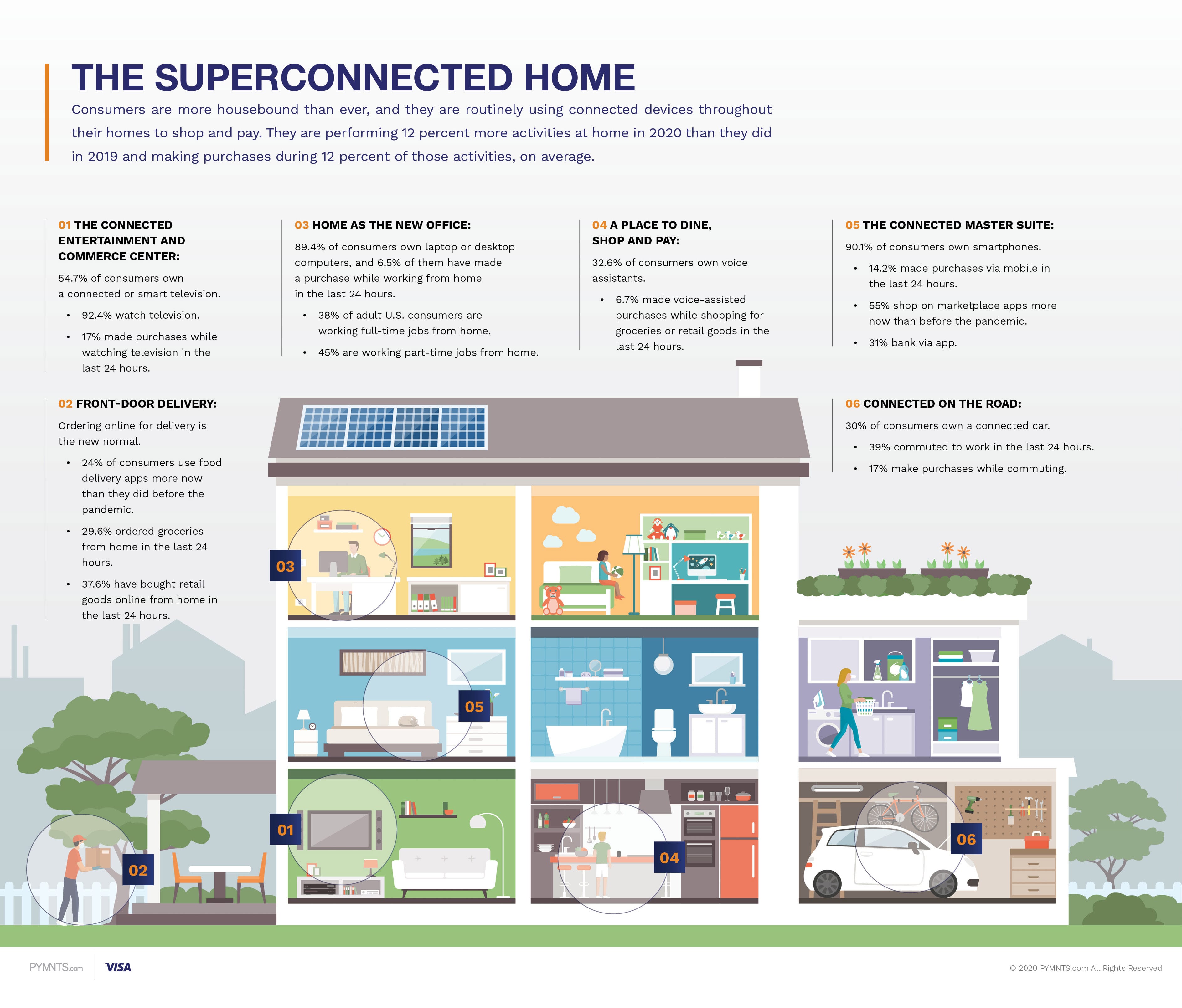
Before 2014, talking to a virtual assistant and instructing it to turn on the lights, start the dishwasher or order up the groceries was the sort of thing the average consumer would more expect to see in a science fiction or superhero movie than in their house. But the release of Alexa and the first Amazon Echo changed all that.
Alexa wasn’t the first voice assistant in the race to catch consumers’ attention — Apple’s Siri beat her to the punch in 2011. But connecting a voice assistant to a smart speaker was novel, and it opened voice as the next channel in the expanding digital frontier for connected consumers.
And “connected consumer” means nearly every consumer these days, as COVID-19 has done the heavy lifting of rewriting consumers’ day-to-day routines end-to-end.
The PYMNTS/Visa How We Will Pay Study; 2020 Edition tells us that home is no longer merely where the heart is. It’s become where everything is, morphing into becoming a commerce command center from which U.S. consumers control nearly all of their daily routines.
Approximately twice as many consumers now shop for retail products from home as did a year earlier, while three times as many relocated their grocery shopping from the store to their homes.
And the “where” of the shopping isn’t the only thing changing. The “how” is shifting as well. Some 23 million consumers are using voice assistants to make purchases — a 42 percent increase from this time in 2018 and a 10 percent jump since 2019.
Habits are hard things to change, but 2020 has been a year that has seen consumers unusually receptive to not only experimenting with new ways to transact, but to actually modifying the day-in, day-out details of how they live. Because the connected consumer isn’t just talking to a voice-activated AI through a smart speaker any more. And they aren’t just asking Alexa for a weather report any more.
The Comprehensively Connected Home

A quick glance at the above chart tells the story of homes that no longer contain a point or two where consumers can interact by voice, but touchpoints sprinkled nearly everywhere. Because, as it turns out, the new consumer has a defined use for all those connection points.
Home offices are rapidly becoming the primary professional workspace, as 38 percent of American adults report working full-time jobs from home. Another 45 percent say they’re working part-time from home.
And yes, they’re shopping while they work. Some 6.5 percent report making purchases while working from home.
In fact, figures show that they’re doing a lot of shopping everywhere. For instance, 55 percent reported shopping more on digital marketplaces now than before the pandemic. Some 37.6 percent also reported having bought retail goods online in the last 24 hours.
Meanwhile, 31 percent had used a mobile banking app, nearly 30 percent reported having ordered groceries from home within the last hours and 24 said they’re ordering food for delivery via apps more than they did pre-pandemic.
Similarly, 17 percent said they’d shopped while watching television, roughly 14 percent reported having made a purchase via mobile during the last 24 hours and 6.7 percent said they’d made a voice-assisted purchase with the past day.
That’s a whole lot of commerce happening across a series of channels — often at the hands of “bridge millennials,” consumers entering their prime spending years.
These slightly older members of the millennial generation (their average age is 36) are the first generation of consumers to have grown up with connected devices on hand. They’ve shown the most willingness to purchase those devices and fully integrate them into what’s in many cases the bridge millennials’ first homes.
Such consumers on average come with a fair amount of disposable income — $95,000 a year on average — and built-in enthusiasm for using connected devices. (They own roughly six on average.)
And those consumers aren’t merely interacting with connected devices more or transacting more by voice because they have to. The data increasingly demonstrate that connected, contact-free commerce is increasingly the way they want to do business.
The Coming Connected Future
The connected-consumer home comes at a time when the entire pattern of commerce is shifting.
A year ago, grocery shopping was a weekend activity for nearly three quarters of U.S. consumers. But now, that’s fallen to 53 percent. Most of the rest are shopping from home, often having food delivered or picking it up curbside. They aren’t reserving several hours of their weekends to do a chore if they don’t have to do in person any more.
The effect is even more pronounced when it comes to non-grocery retail journeys. PYMNTS surveys show that 46 percent of consumers are now shopping for retail items on the weekend, down from 65 percent in 2019.
And to make those purchases, millennials and bridge millennial consumers are often turning to voice assistants to act as their commerce concierges.
Add it all up, and the future of payments seems to have actually arrived. It’s happening in living rooms and kitchens across America as consumers adapt their lifestyles around increased connectivity. That means the questions is no longer “when is it going to get here,” but “now that it is here, how will it develop going forward?”